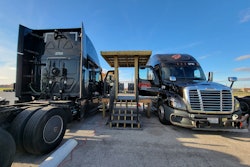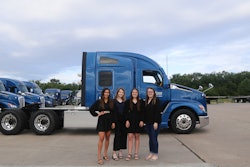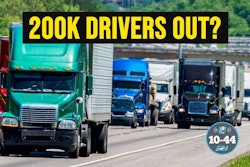
CCJ Innovators profiles carriers and fleets that have found innovative ways to overcome trucking’s challenges. If you know a carrier that has displayed innovation, contact CCJ Chief Editor Jason Cannon at [email protected] or 800-633-5953.
Dohrn Transfer Company has multiple initiatives in place – from smart inflation tires to driver gamification that encourages eco-friendly driving practices – to enable the carrier to save 1,400 tons of CO2 annually. But one of its sustainability efforts in particular has led the company down a new path that has resulted in benefits beyond reducing emissions.
The Rock Island, Illinois-based company, which offers both truckload and less-than-truckload services, transitioned to digital delivery receipts in 2022, previously using printed paper copies in duplicate – one copy for the customer and a signature copy for the driver to return to the terminal at the end of the day. But that shift opened a whole other can of worms.
Heather Dohrn, executive vice president and chief commercial officer at Dohrn Transfer, said going digital was disruptive to its largest client’s operations. Upon delivery, the driver shows the consignee their tablet, which conveniently eliminates the need to sign multiple documents but can make it challenging for consignees receiving hundreds of shipments per day because it's hard to expose all of the reference information on a tablet display. It also was cumbersome for the drivers when they had to flip through all of the bills to find the description of freight, she said.
Dohrn said she personally called all of the company’s customers that had expressed to drivers that they didn’t want digital delivery receipts to discover the reason behind it and how to overcome it. In some cases, it was simply a novel process that they needed to understand better, but for those receiving multiple deliveries a day it was more challenging. She said it was difficult for them to know how many pieces they were supposed to be checking in for each shipment; they don’t always know what was ordered, who ordered it or where it needs to go in their company.
All that information is now available on a single page, allowing the consignee to check-in the freight from one document.
Dohrn Transfer uses transportation management software provider Carrier Logistics Inc.’s FACTS system for digital delivery receipts, so the carrier approached the provider with the idea to create departure reports.
“When we first started this journey, our primary objective was related to sustainability, reducing paper, and reducing our carbon footprint,” Dohrn said. “It was very interesting to learn that the reliance on paper was more than just an environmental problem. It was actually a process problem. Once we improved and automated the transmission of the details of what shipments were going to be delivered, processes at the receiver could improve.”
Dohrn Departure Report
The Dohrn Departure Report, in use for about six months now, provides key information, including terminal departure time, trailer number, shipper name, pallet count and weight, bill of lading and purchase order numbers, and accurate delivery ETA. An accompanying Excel file allows users to click on a PRO number to see revised ETAs and a live map showing the driver’s current location.
 Carrier Logistics Inc.
Carrier Logistics Inc.
Dohrn said she consulted with customers who had the most detailed information requirements to determine what to include on the report.
“We created a mockup using all of the reference numbers, handling units and descriptions that we felt were needed,” she said. “We got feedback from these customers and created the report using their suggestions.
“Our customers love it because it gives them the ability to be able to plan their day better – pass that information on to whoever's receiving it so that they know what's coming,” she added. “It helps them to be able to let their customers know if something needs to be turned around and sent back out the same day, what they're capable of, and then also just plan their workforce based on what's coming in to them.”
The report is delivered via email or text. When the driver’s trailer is loaded and dispatched out for delivery, that update triggers the report to be pushed out. CLI President Ben Wiesen said this ensured absolute accuracy and still provided sufficient advance notice to the receivers. ETAs are generated from sophisticated AI algorithms, which incorporate predictive traffic, expected time at stops and other data to determine the most accurate ETA. If a driver is delayed at a previous stop or by weather, the ETA updates. Wiesen said predicted weather is not currently incorporated because the reports are last mile and not used to predict potential disruptions early in transit. All data used to automate these reports comes from the CLI FACTS system.
While Dohrn approached CLI to create these reports primarily because of one of its largest clients, the company offers the solution to all of its customers, and CLI is able to provide this service to its other customers as well.
“It was something that we approached them about developing,” Dohrn said. “We've worked with CLI closely for many years, and so we often give them ideas of things that will help us out, and they work with us to develop it, and then that gives them something that they're able to offer to other customers as well.”
Customers must opt in to receive the reports.
One of the biggest trends in the industry recently has been customers asking for real-time visibility, but the LTL industry, Dohrn said, has traditionally been reactionary and behind when it comes to proactively pushing out information. She said Dohrn Transfer wanted to communicate information to the customer before they even came looking for it to help them improve operational efficiency. The result has been the same for Dohrn Transfer because it has reduced driver wait times by allowing customers to pre-plan for the arrival of goods instead of relying on a paper-driven reactionary process. The carrier has seen additional benefits, including greater customer satisfaction, Dohrn said.
“We believe that we are the first carrier to offer this kind of proactive report,” she said. “Many carriers will push reports of what freight is due to deliver on any day. However, this report gives real-time updates of the freight that is actually out for delivery …
“It gives our customers the ability to be ready for the driver to arrive … but on top of that, it's enabling us to do more electronic delivery receipts, which is one of our initiatives towards sustainability, and it’s also completing that digital supply chain cycle … which eliminates the need to break that digital cycle and create manual work and introduce errors because humans have to enter things,” she added.
The CCJ Innovators program is brought to you by Bestpass, Chevron Delo, Comdata and Freightliner Trucks.














